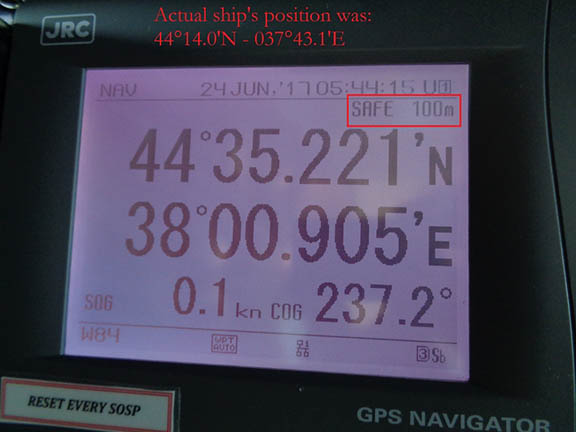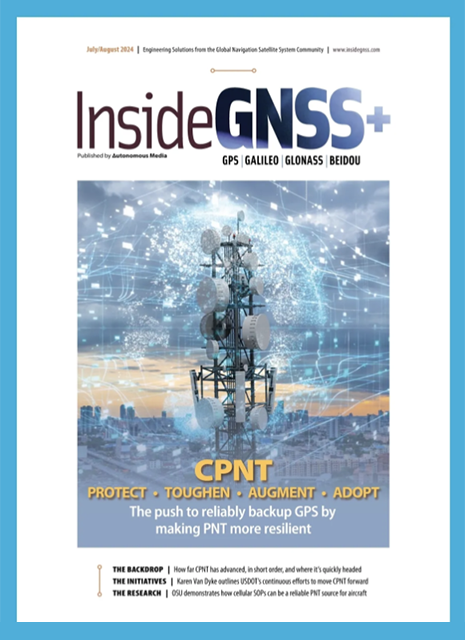The spoofing and jamming threat continues to grow, making GNSS resiliency for warfighters a hot topic at ION’s JNC 2024.
Many of the exhibitors at ION’s Joint Navigation Conference (JNC) had one thing in common: they spent a lot of time talking with attendees about solutions designed to strengthen PNT by backing up GNSS or thwarting spoofing and jamming attempts. Mitigating the threat of nefarious actors is a top industry concern, and that was evident in many of the solutions displayed at the conference.
This year’s theme, “Robust, Resilient, Assured PNT for Warfighters and Homeland Defense,” says it all. We’re at a critical point, and now is the time to not only develop, but also field technologies that strengthen PNT. You can sense the urgency in the industry, with many exhibitors like Lou Pelosi of CAST Navigation saying this year’s JNC, held in Convington, Kentucky, was one of the busiest in recent memory. Users are looking for solutions that give them that needed resiliency, and manufacturers are answering the call.
Show Launches
About 60 exhibitors attended this year’s conference, with some using the show as an opportunity to unveil new solutions. VIAVI was among them, introducing the altGNSS GEO SecureTime service. Available worldwide, the service aims to deliver improved nanoseconds-accurate UTC timing via L-Band and Ku-Band satellite signals—becoming only the third global independent capability that generates PNT signals locally.
The service is independent of traditional GPS and GNSS and, because it operates on the Ku-Band, it is difficult to jam or spoof. Its Navigation Message Authentication (NMA) uses encryption to detect spoofing in any signals, both cooperative and non-cooperative, received from any source.
“Our service is going to be very, very low cost and potentially rolled into hardware, which means you don’t have to maintain monthly licensing or fee tracking,” said Said Jackson, VIAVI’s general manager and vice president. “You buy a piece of equipment from us, you plug it in and it just works. It can be bought as a physical product as well as a module to integrate into a system. It’s also signal agnostic, an important feature.”
BAE Systems introduced NavStorm-M, a gun-hardened integrated anti-jamming and GPS receiver with M-Code capability that can be leveraged for artillery, missiles and unmanned systems.
With this launch, BAE Systems has updated nearly all of its GPS receivers with M-Code capability, giving warfighters access to equipment that is more resistant to spoofing and jamming.
“When customers are ready for a tech refresh or new build, we have M-Code,” said Justin R. Wymore Sr., customer requirement manager, weapons PNT, navigation and sensor systems. “The user equipment is available. Now, it’s just a matter of integrating and fielding it.”
New Ways to Detect and Mitigate Jamming
UHU Technologies highlighted its Northstar and UHU1000 solutions at JNC, generating a lot of interest from attendees. Northstar detects spoofing and jamming in a matter of seconds, Senior Design Engineer Eric Hughes said, leveraging advanced multi-element digital signal processing to spatially identify and separate real GPS signals from fake ones. It calculates the angle of arrival (AOA), making it possible to determine if the signal is from a valid satellite or a spoofer. AOA is the only signal feature that can’t be spoofed.
Through this technology, the AOA is compared to the known satellite location for the signal. The box then spatially nulls any spoofers or jammers.
The UHU1000 has the same features but takes it a step further, both detecting and mitigating threats, Hughes said.
“Traditional anti-jam systems suppress at above the noise,” he said. “If a signal is faked below the noise, they can’t see it. We can look below the noise and see the spoofing and suppress it using advanced bellow the noise nulling.”
The solution has two radio frequency (RF) outputs, Hughes said, with traditional anti-jam and the company’s anti-spoofing technology. It has seven inputs and works with both SAASM and M-Code.
PSIONIC also takes a different approach to RF and jamming mitigation, with its new laser-based sensor, SurePath. The sensor features a proprietary navigation filter that uses real-time velocity vectors to correct IMU sensor errors, enabling it to provide information in one platform that typically requires multiple. And, according to the company, the undetectable velocimeter can’t be spoofed or jammed.
SurePath takes multiple line-of-sight measurements to determine the vehicle’s surface relative velocity vector. Measurements are made from the vehicle against the surface’s reference frame, with surface relative velocity measured in real time.
“It measures velocity directly in the Doppler Effect,” Senior Staff Scientist Jeff Monaco said, “so you know not just how fast it’s going but in what direction. Other solutions just give the speed measurement. This provides the velocity vector.”
Chelton displayed various anti-jam solutions at the meeting, including the DACU4c. This high-performing system integrates a four-channel controlled reception pattern antenna (CRPA) with advanced, miniaturized GNSS anti-jam processing electronics. It integrates easily and is suitable for retrofitting.
“We’re taking the existing building blocks and putting it all in one package,” said Andew Cowan, chief engineer, avionics. “All the bits are proven and mature technology, but this is the first time it’s been put into a single package.”
The company also highlighted its M-Code compliant 20-8000 eight-element conformal CRPA that’s designed to fit seamlessly into the skin of an aircraft, as well as the more compact four element conformal CRPA, the 20-7550. The customizable antenna is M-Code compatible, operates across GPS L1 and L2 bands and is designed to work in demanding environments.
AEVEX Aerospace highlighted its Geo-APNT, a fully integrated GPS-aided inertial navigation solution that offers users the assured position, navigation and timing their use cases require, even when GPS isn’t available.
Geo-APNT features in-motion dynamic alignment and is available with M-Code/SAASM or commercial GPS receivers. It also supports a variety of inertial measurement units (IMUs) based on user need, including MEMS, fiber optic gyroscopes (FOG), ring laser gyroscopes (RLG) and navigation grade IMUs, said Mark Glover, retired U.S. Navy Capt. and senior director of business development for assured positioning, navigation and timing. An anti-jam antenna can be integrated into the box for added protection.
“This is our most complex box,” Glover said, “because of the number of integrated sensors.”
Companies continue to collect data to enhance current and future solutions designed for GNSS contested environments. VectorNav Technologies, for example, announced its participation in the USAF’s NAVFEST 2024 Test Event. The event was hosted by the 746th Test Squadron at Holloman Air Force Base, New Mexico, and held at White Sands Missile Range (WSMR).
During the event, VectorNav evaluated a range of its single and dual-antenna GNSS-Aided INS products, including the VN-210, VN-310, VN-210-S, VN-200, VN-300, VN-210E, and VN-310E in various configurations. The products were also tested in combination with a variety of additional PNT systems.
The data collected is being analyzed to further refine and enhance VectorNav’s solutions in GNSS-contested environments.
Advanced IMUs
Safran Federal Systems also made a few announcements at JNC, launching two new IMUs that leverage advanced MEMS and core Hemispherical Resonator Gyro (HRG) technology: Iconyx and the Small Tactical IMU (STIM).
The tactical grade IMUs are designed to bring high performance to unmanned applications and space-based operations. Safran also announced that Geonyx, the company’s HRG based inertial navigation system (INS), now features anti-spoofing M-Code capability.
The HRG Crystal offers a lower size, weight and power (SWaP) capability than traditional options like FOGs and RLGs, said Jon Leombrone, executive vice president of navigation systems. This next generation of gyro technology doesn’t need to increase in size to achieve better performance.
“This technology [HRG] always stays the same size,” Leombrone said. “The SWaP is part of the value proposition.”
Enertia Micro highlighted its HRG technology at the conference. The company’s Birdbath Resonator Gyroscope (BRG) is the result of 20 years of R&D at the University of Michigan, under the support of DARPA, Enertia Micro Vice President of Engineering Jong Kwan Woo said. The company’s two solutions serve as dead reckoning IMUs for autonomous vehicles and drones, with BRG-5 near aviation grade and BRG-10 aviation grade.
The BRG products provide better accuracy at a lower cost, size and weight than other gyroscopes, Woo said, because of the fused-silica MEMS resonator.
“There’s lots of interest to test this device; there are a lot of companies and government agencies looking for this,” Woo said. “We can make the device small, so it fits in a lot of applications.”
Fizoptika Malta highlighted its miniature 3-axis FOGs, which are combined with MEMS accelerometers, and FOG-based inertial measurement units. Managing Director Arthur Tua described the company’s FOGs as “the world’s smallest,” offering the low power customers need.
“All our products are lower power, which is beneficial when power is at a premium,” Tua said. “And to make it easy for buying, they’re all ITAR free.”
The company offers various options and performance parameters, Tua said, and can be used in autonomous vehicles and drones as well as for gimbal and camera stabilization. The small cylindrical FOG IMU U123D, for example, offers 1°/h bias stability and 0.05°/√h ARW and low power consumption of 1.5W, while the G181 and G121 three-axis FOGs deliver low noise performance in ultra-compact and lightweight units.
Fiberpro also displayed its FOGs and three-axis IMUs. The company’s FN 200C box, for example, is a GPS-aided INS that leverages tactical-grade FOG technology. It combines INS with Attitude and Heading Reference System (AHRS), MRU and a FOG IMU-based AHRS. It can determine position, velocity, vertical and horizontal displacements and absolute orientation on any device it’s mounted on.
The FI 210 IMU is a high-performance IMU that integrates three FOGs and three accelerometers, while the FG 150 is a single axis FOG for stabilization applications such as antennas, aircraft cameras and armored vehicles.
The navigation grade units are ITAR free, U.S. Branch Manager Richard Ryu said. They’re also competitively priced and have a shorter lead time than other options.
A Well-Rounded Conference
Other exhibitors included CAST with its simulators, such as CAST Navigation Jammers and CAST-CRPA simulation systems, Tualcom, TRX Systems, Honeywell, Inertial Labs, Hexagon | NovAtel, oneNav, ANELLO Photonics, Septentrio, NavtechGPS, Ideal Aerosmith, GPS Networking and Xona Space Systems. Attendees also had the opportunity to network and take in various sessions, with topics including Complementary PNT, inertial navigation technologies, field testing PNT technologies, PNT for uncrewed systems AI/machine learning for PNT and anti-jam and anti-spoofing technologies.
Next year’s JNC is slated for June 2 to 5 at the Northern Kentucky Convention Center, where the focus on mitigating spoofing and jamming threats and backing up GNSS are sure to once again be hot topics.






